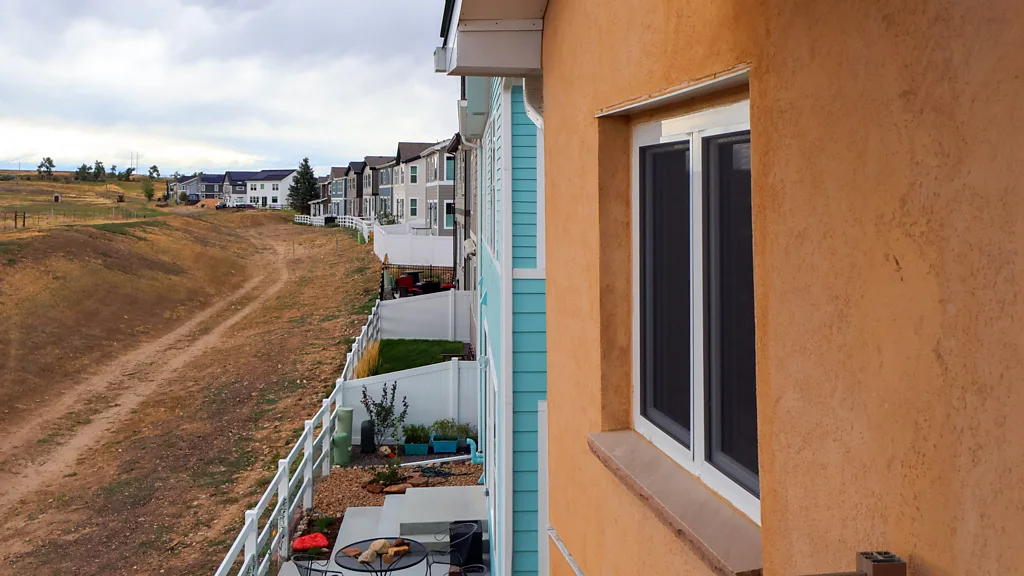
‘I Said to Myself, Dirt Doesn’t Burn’: The People Rebuilding Their Homes with Earth
These people are rebuilding homes lost to wildfires in the western US – only this time they are using a material that they hope won’t burn.
Melanie Glover’s back window opens to a sweeping view of the Rocky Mountains. When she rebuilt her home in summer 2024, she wanted to keep this view.
On 30 December 2021, rapidly moving winds had carried hot flames across these plains to her neighbourhood in the Denver suburb of Superior, Colorado, destroying her home and nearly 1,000 others. Her husband, Matteo Rebeschini, and children were trapped in the front foyer for 30 minutes as their house burned, before escaping unharmed once the fire passed.
The fire brought trauma that lasts to this day, but Glover and Rebeschini were determined to rebuild. So they did – only this time, they used earth blocks.
“We want to be able to feel safe,” says Glover. “We wanted to build a house so that if something like this happens again, we have time.”
When Glover returned to her property after the fire, she found flowerpots that had melted, leaving several unharmed piles of dirt behind.
Earthen homes have a deep history throughout the world, from pit cave dwellings in northern China to the mud homes of Sana’a, Yemen. Indigenous communities in the south-western US states of Colorado and New Mexico used adobe, or “mud brick” in Spanish, to build earthen homes for thousands of years, using their thick walls to keep homes cool during hot summers and retain the sun’s heat during cold winters.
While earthen construction has been largely neglected by US builders for decades, the material has an increasingly relevant use in modern times. As climate change increases the risk of wildfires through the western US, homeowners like Glover are beginning to turn to it for a new reason: as a strategy to protect themselves from fire.
Their intuition is backed up by early research, which has found earthen homes could show extraordinary promise in resisting wildfires – and could even strengthen after exposure.
“Properly done and more historically done, an adobe house has a better chance of surviving a wildfire,” says Quentin Wilson, a former volunteer firefighter and a board member of Adobe in Action, a non-profit based in Santa Fe, New Mexico which promotes building with earth.
That said, traditional adobe homes in New Mexico are hardly fireproof – they generally use protruding wooden beams called vigas, which can easily catch fire.
But when adobe homes are constructed with the threat of fire in mind, builders can eliminate things like exposed wood and air vents, often adding earthen beams or in some cases large planks of wood that don’t protrude from the house. “There’s really nothing there that will ignite,” says Wilson. “These are pretty much absolutely fireproof, flameproof materials.”
In 2021, Michele Barbato, co-director of the Climate Adaptation Research Center at the University of California, Davis, and his students did a series of tests on compressed earth blocks, made at his testing area using soil mixed with water and chemical stabilisers. The researchers took a blowtorch to a compressed earth block at nearly 1,900C (3,452F), far hotter than an average wildfire. They also put a block in a 1,200C (2,192F) furnace.
Upon exposure to heat, the blocks hardened and turned to red clay, similar to baking pottery in a kiln. More than just showing the earth blocks can withstand fire, the tests – which have been presented as a peer-reviewed conference paper but are not yet published in a journal – therefore indicate they strengthen after exposure. They perform just as well in dry climates, Barbato says, while in wet weather, they even improve, as the material hardens making it tougher for water to penetrate.
“Even if your house burns down, if the walls stay up, they are safe to be reused,” he says.
At present, however, no houses made with these blocks have yet been put to the test with a fire, although a test has been conducted on a single wall.
But while it is early days for the research on earth bricks, some real-life examples do appear to indicate these houses could be capable of withstanding fire more than other buildings. When the Bobcat Fire swept through Littlerock, California in 2020, for example, the land around Stevie Love’s earth home, built in 2008, was blackened by fire for miles around, but her home survived.
A few years earlier, a fire crew prepared for another wildfire to potentially cross the hills behind their home. “They described our house as a ‘stand alone’,” Love says, meaning that if a fire came, its adobe walls and steel roof would protect it. “They said the fast-moving fire would just blow by our house.”
And in 2016, in the Manzano Mountains of New Mexico, the Dog Head Fire burned through 18,000 acres (7,280 hectares) and destroyed 12 homes – but an old adobe church standing alongside them was left intact.
For Glover, an avid gardener, her inspiration to build from earth came from her garden.
After the 2021 fire, she returned to her property and found flowerpots that had melted, leaving several unharmed piles of dirt behind. “I said to myself, dirt doesn’t burn,” she recalls. “We should build a house of dirt.”
Glover, who is from Northern Ireland, and her Italian husband were both used to earth and brick structures with thick walls from their home countries. “It didn’t scare me,” she says. “Whereas having a conventional stick-built American house scared me.”
Not long after the fire, Glover drove past a billboard advertising Colorado Earth, a Brighton, Colorado company making compressed earth blocks called EcoBlox from waste material sourced from a local quarry.
Lisa Morey, the founder and owner of Colorado Earth, has been building with earth blocks since 2000, when she came across the work of earth builder Vince Ogletree while studying architectural design in New Zealand.
The company’s earth blocks are made by mixing dirt with limestone and water, then using a hydraulic press to compress them into solid blocks that are ready to use once they dry. Unlike bricks, they’re made without being heated, dramatically reducing the embodied carbon used to produce each block, Morey says.
“[An EcoBlox wall is] an unfired structural masonry wall that’s made from local materials,” Morey says. “It’s resistant to mould, fire and bullets. And bugs don’t like them.”
Barbato’s work has also indicated that earth homes could lead to substantially fewer emissions if they do burn in wildfires, with another peer-reviewed conference paper finding earth block building results in 58% fewer emissions than light-frame wood buildings.
Tiny beads of perlite, a lightweight volcanic glass used for insulation, blow into Morey’s hair as she walks around a construction site in the Denver suburb of Longmont when I visit in late September 2024. Here, a family is rebuilding a farm complex that was destroyed in a fire several years ago.
Melanie MacKinnon says she and her husband had already been thinking of rebuilding when the fire happened. “When we moved here, we had a plan for the farm,” she says. “After the fire, we realised that the farm has a plan for us.”
MacKinnon grew up in Santa Fe, New Mexico where adobe buildings are commonplace. “I know what it’s like to live inside of that,” she said. “We don’t need air conditioning. It’s fire resistant because it’s not made out of timber.”
The earth homes being constructed by Morey have additional features that prevent wildfires, designed to increase the odds a rapidly moving fire will pass without finding something to catch onto and ignite.
Glover’s completed home, for example, has thick, high-efficiency windows that, in a worst-case scenario, would take hours for fire to penetrate. There’s a total absence of protruding roof vents, which can give flaming embers an avenue to get inside. Instead, there’s a centralised ventilation system that can be closed in minutes when experiencing strong winds. “Fire’s not going to get into the gaps,” she says. “It’s completely sealed.”
These add to what already feels like an envelope of protection from the elements. “My clients who live in these homes, they say that there could be an Armageddon going on outside and they wouldn’t know,” Morey says.
Glover says windy days still bring traumatic memories of the fire that destroyed her previous home and took the lives of several pets. For weeks after the fire, she would lie awake imagining the destruction. “It was just flames, flames, flames. It’s horrible,” she says. “It’s your home. It’s like your sanctuary.”
As she speaks, an impromptu windstorm sends strong gusts through her backyard, lashing her balcony and metal flower beds. But inside her living room, it barely makes a sound.
“That would be a lot more intense in a normal house, just so you know,” Glover says.
Glover knows that the house is not infallible. “I have never said that this house is fireproof,” she says. “The blocks are fireproof. But… I can’t live in a house without windows and [a] roof. And I’ve done the very best I possibly can.”
There is still an uphill battle for more earth homes to be built throughout the United States, where fast-paced construction with environmentally unfriendly materials is normalised.
Several of Glover’s neighbours considered building earth homes after the 2021 fire. But they ultimately opted against it, spooked by the challenges of closely managing a project seen as eccentric by most builders.
Glover kept costs down by serving as her own general contractor, meaning she and her husband were heavily involved in design decisions and engaging with builders.
Ultimately, their home cost around $280 (£210) per sq ft to build – more expensive than traditional homes in the community, which were built for around $250 (£188) per sq ft, Glover and Morey say, but less than many other green buildings.
The savings on utilities (due to higher energy efficiency) also bring costs down over time, though, says Glover.
Labour costs, the bulk of the expense, could potentially be reduced with machines that mass produce earth blocks. The material itself ranges from free to cheap. Morey says she spends $4 (£3) for each tonne of dirt. “And I can make about 100 bricks from that $4,” she says.
Still, earth builders can also be stopped in their tracks by bureaucracy, says Ryan Timmermans, a military veteran who founded Veterans Off-Grid, a non-profit providing assistance to veterans in need on a 50 acre (20 hectare) off-grid campus in Carson, New Mexico.
Timmermans has constructed several earth buildings on the property, from small adobe huts to an Earthship, an off-grid structure built with walls of rammed earth and tires. These structures are designed to more effectively resist the winds that tear across the vast northern New Mexico plateau, he says. There is also a chance of wind carrying fire across a plateau.
But the wider construction industry has yet to adapt, from builders gaining more knowledge to insurers and mortgage lenders creating policies to accommodate earth homes.
“If a wildfire consumed it and there were trees all around, 60% of it would still be there,” Timmermans said, pointing at the nearby Earthship. “Why the hell is it more expensive to insure?”
Barbato, the researcher, is part of a team working on a set of standards that would help local governments set codes for earth building in the US.
Some earth builders mix dirt with binders such as cement to make them stronger, as they “have been pushed by standards and codes to really treat them as bricks”, he says. “And that’s not really the right way of using this material.”
Instead, the dirt can be stabilised with “a proper composition between clay, silt and sand” Barbato says, which also gives earth blocks the breathability that either sucks in or releases humidity, keeping a home from ever getting too hot or too cold.
With the proper codes in place, “we can bring the cost of an earthen home lower than the cost of a wooden home”, Barbato says, citing a study he co-authored in 2018 evaluating an earth wall technology his team is currently developing.
He believes this will clear a major obstacle to widespread earth construction: familiarising people with it. Once that’s done, he believes, “it’s relatively easy to convince the public this is a great solution”.
External Link: BBC News
Internal Link: Kenkou Land





